Memories of Yesteryear
Part 6
All You Need Is Love (and a bike)
In my last chapter I endeavoured to give you a brief insight into the motorcycling world in the mid-1920s. This chapter continues this fascinating historical thread, starting at the beginning of the 1930s which proved to be an extremely rich period in motorcycle evolution.
However, with Valentine's Day in mind, you'll perhaps forgive me if I take a moment to celebrate the occasion on LPMCC.net as I attempt to bring together the two, (at times contradictory) topics of love and motorcycles. Not the easiest of challenges to combine perhaps, but remember, lovers and couples associated with motorcycle are one of the many themes to be found illustrated in the history of the postcard, humorous, sentimental or otherwise, in drawings, photographs and cartoons.
So please join me as we wander through time together, leafing through some of my postcard archive and turning up stories in the evolution of the postcard over the centuries.
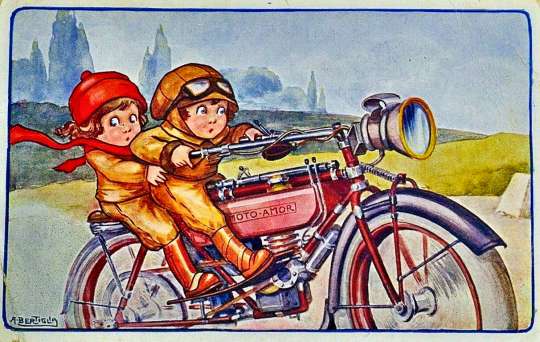
This old Italian postcard depicts two young lovers riding a motorcycle of the imaginary brand 'Moto-Love', perhaps on their way to seventh heaven!
Pre-dating the arrival of the 'little printed card' that was posted at one time or another, the sending of open messages actually dates back to ancient times.
During the fourth millennia in Assyria, clay tablets were inscribed with messages and more recently visiting notes were written on playing cards in the reign of Louis XIII; traces of which can still be found in the archives of the post offices in Paris dating back to 1777.
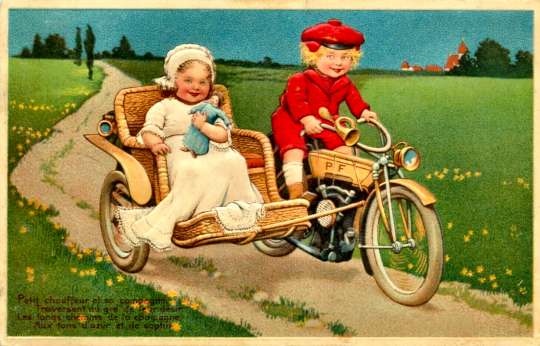
A postcard of French origin and probably printed at the beginning of the 1930s
In France, during the second half of the 19th century, glossy commercial cards were in circulation containing advertisements. These were one of the first examples of marketing messages and took the form of small cards, although they had no personal aspect to them and were purely to sell products or advertise services.
The official concept of the postcard though as we know it was not really yet ubiquitous.
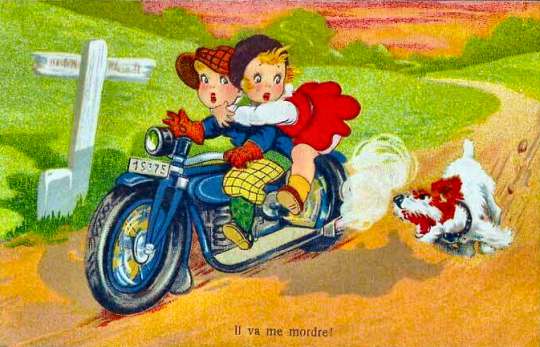
Journeys on two wheels in the countryside were not without danger and surprises. These early illustrations often show an animal unexpectedly crossing the path of the motorcycle, a dog chasing it, a puncture, a mechanical breakdown, or even perhaps a fall!
The term correspondence card was first used in 1869 by an Austrian called Emmanuel Hermann and, to simplify the postal system, he managed to convince the Austrian postal administration to use the generic term 'correspondenz-karte'.
Thus the postcard was born: a rectangle of stiff paper, printed on the front with text and space reserved for a stamp; the reverse left blank for correspondence.
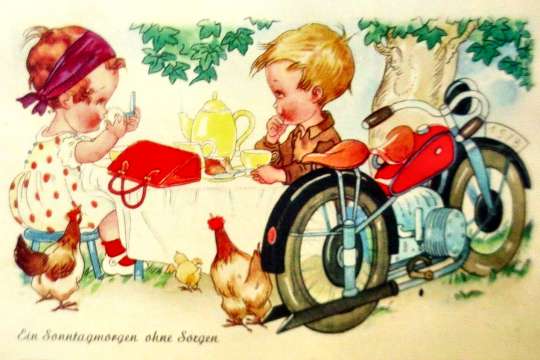
When you finally arrive at your destination without a hitch, what could be more romantic than a picnic in the great outdoors with your lover?
This shameless correspondence, (open for all the world to see), was derided in France and UK for its lack of discretion, but it sold more than 45,000 copies on its first day of publication.
The postcard arrived for the first time in Strasbourg, France in 1870,which was being besieged by the German army at the start of the Franco- Prussian War. A card bearing the Red Cross stamp was circulated by the Wounded Relief Society in an attempt to allow the civilian population to communicate directly with the outside world.
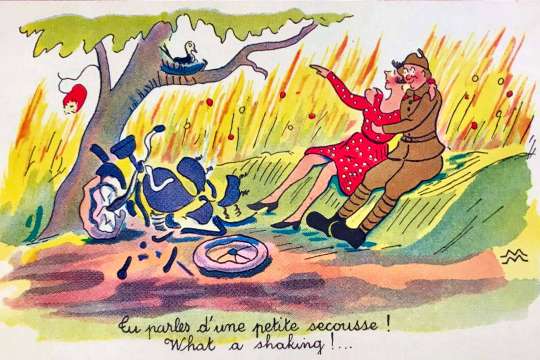
This French postcard, written in English and French dates from the Great War. The French soldier seems more interested in embracing his partner than repairing his motorcycle after hitting a tree. After all, everything seems ok. The bird is still in its nest. The tree is still firmly in place. It's just the machine that seems to need a little attention...
It is interesting to note dates on which postcards were mailed for the first time:
1870 - Switzerland, Great Britain
1871 - Belgium
1872 - Russia, France
1873 - United States (stamped by the government), Romania, Japan
1874 - Germany
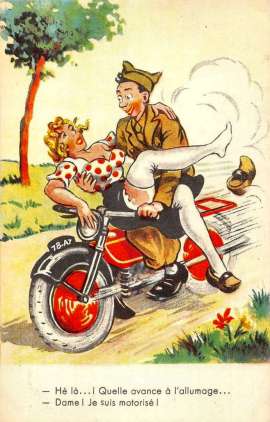
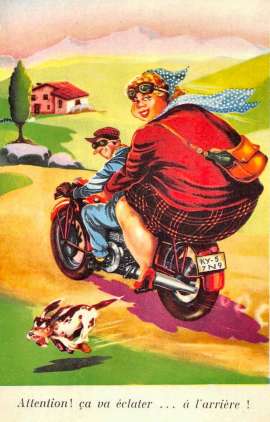
Since it is impossible to translate a pun with finesse from one language to another, let's let these two old French humorous cards speak for themselves. I'm sure you can provide your own captions…
Outside Europe, in 1871, Canada was the first country to permit the use of postcards as a legitimate form of postal correspondence and measured strictly three inches by five.
At that time, it was a state monopoly and only the Postal Service was licensed to issue them and the only Illustration was the face of Queen Victoria, printed on the top right of the front of the card.
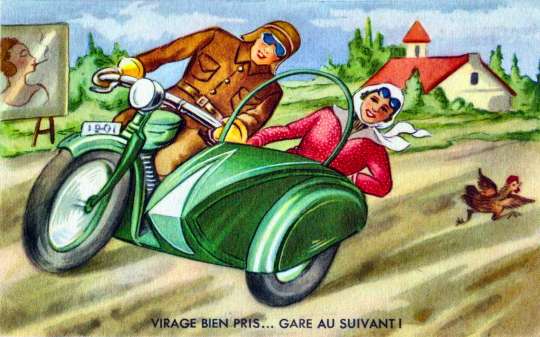
The chicken on the right of this Belgium postcard seems to have barely escaped the passage of this couple. Note the sign on the left showing a poster presumably for a cigarette brand at a time when smoking was fashionable.
The basic idea behind the creation of the postcard was to encourage more correspondence at an affordable postage rate and this was the case from 1873 to 1971. For almost a century the postcard benefited from a lower rate than ordinary mail.
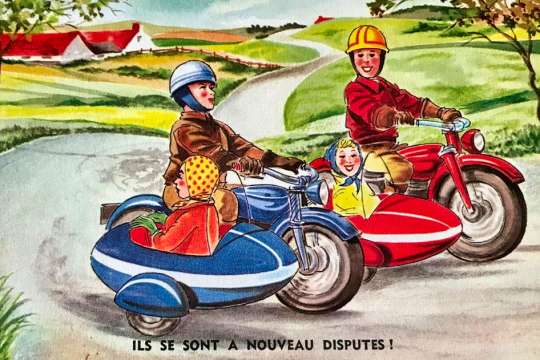
The caption of this French postcard let us know that this couple has just had an argument.
This fashion for postcards increased proportionately in line with the rise of general literacy, and since the telephone didn't yet exist, more and more people came to realise the usefulness of this fast inexpensive method of sending messages.
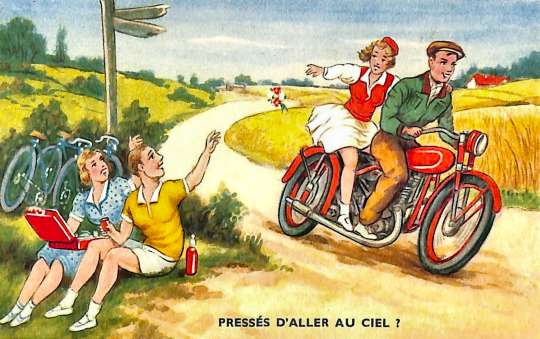
The caption asks this couple of motorcyclists if they are in a hurry to see their maker!
Until 1875, the postcard remained a monopoly of the French 'Administration des Postes', but now manufacturers and those with goods to sell capitalised on this new form of messaging by printing advertisements on the back.
This was the case for the Belle Jardiniere in Paris from 1873.
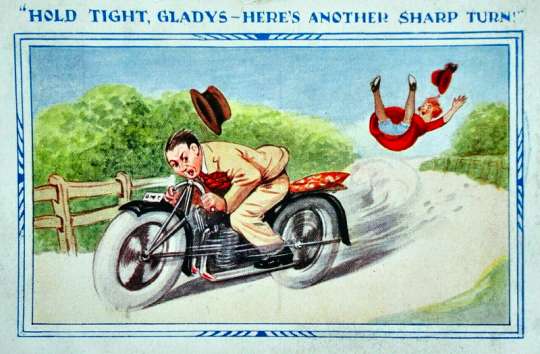
English postcards also represented the dangers of motorcycling
A decree of 6 October 1875 ratifies the use of postcards, and liberalises their production as long as they respect the standard model: 12cm x 8cm, weight between 2 and 5 grams, with only the address on the front and correspondence and illustration on the back.
The international mailing of postcards began in 1875 after the first meeting of the General Postal Union in Bern.
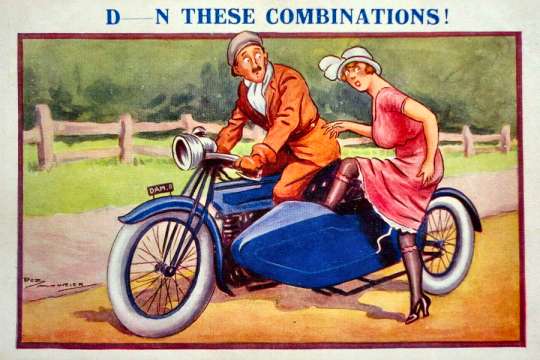
British ladies' outfits from days gone by were apparently not made for motorbikes
It was not until 1889 that the first illustrated postcard called 'La Libonis' appeared in France, named after the designer Leon Charles Libonis who created it.
The Societe de la Tour Eiffel published 300,000 copies during the Universal Exhibition and five different designs were sold from August 1889.These souvenir cards of the ascent of the Eiffel Tower could be stamped at the first platform, the second or the top of the Tower.
Returning to Paris in 1900, the Universal Exhibition marked an explosion in the use of postcards. Production rose from 100 million in 1910 to 800 million in 1914.
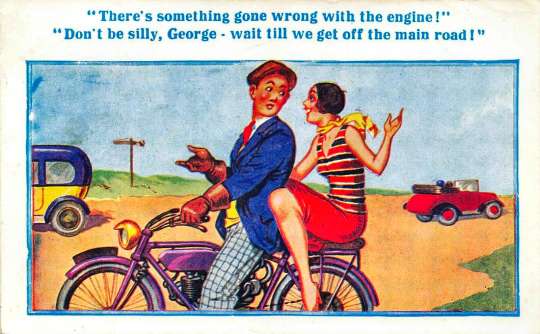
This old English postcard proves that to claim to break down must not only be an international trick but invented from the very start of motorised transport
The UK was slower than its continental neighbours to latch onto the possibilities of picture postcards, and it was not until 1894 that the Post Office agreed to their private publication.
Plain postcards were introduced prior to this in 1870, and some illustrated and advertising cards were used with pre-printed stamps, but their general use and popularity were limited.
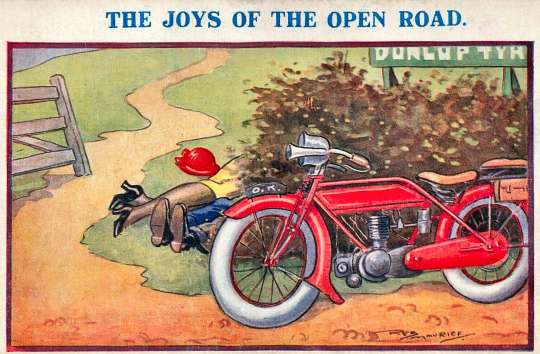
Apparently, the trick of claiming to break down worked well. No need to wait for Valentine's Day for your sweetheart to offer you a special treat…
Even after 1894, picture postcards did not immediately become a success in the UK. Early examples tended to show seaside and city views rather than subjects or themes.
By 1902 however, things were changing. Postcards were published featuring the such diverse subjects as the Boer War and prestigious royal events, and in that same year the Post Office allowed both address and message to be written on one side of the card, freeing up the whole of the other side for the picture.
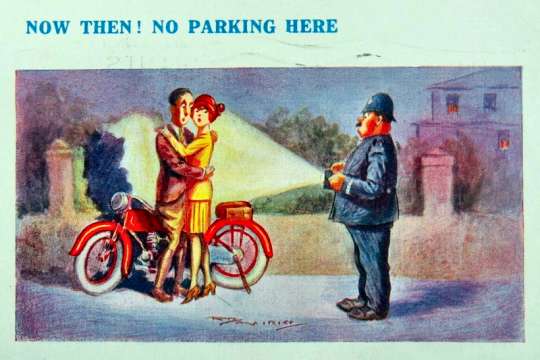
A postcard that confirms that whatever country you live in, even when you don't do anything wrong, the police are often around to intervene.
Britain thus became the first country to introduce the 'divided back' postcard format we are familiar with today. By this time, too, the size of cards had been largely standardised.
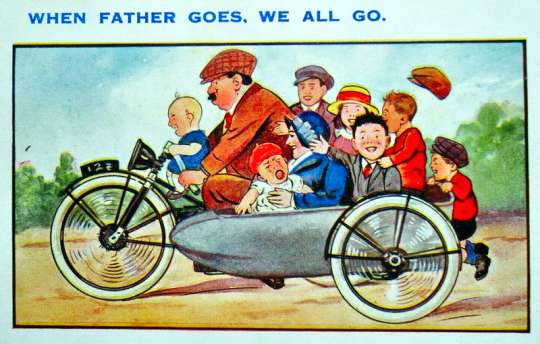
After the flirtation, the first dates, the first kisses, the love affairs, came the engagement followed by marriage. Then came the foundation of the family like that of the prolifically fertile couple seen above
At the end of the 19th century however, images as we know them were still a rarity, and only a few posters and engravings in books and newspapers were available to the general public.The cinematograph had only just been invented (1895) and was still a curiosity.
The low cost of illustrated cards proved very successful and many postcards circulated and enriched the collections of the first 'cartophiles'.
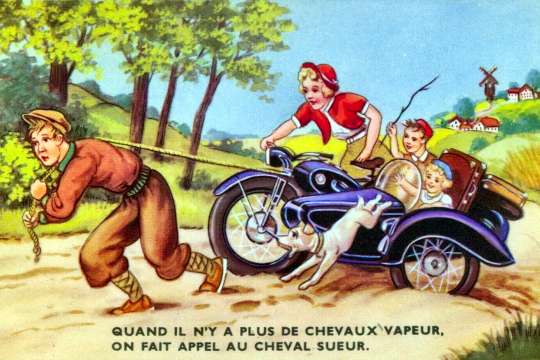
The legend of this French postcard displays another subtle pun, playing on nuances of mechanical terms, which I find difficult to translate into English. Horse power in all its various forms is the basis of the pun.
From 1900, postcards and illustrated leaflets took on a new dimension as more and more businesses used postcards to make themselves known as an early form of postal marketing, and in 1904 another change took place: the front was now entirely occupied by illustration and the back was reserved for correspondence and address.
The decade from 1910 shows the almost journalistic role played by the postcard with the depiction of train or bus accidents, demonstrations, strikes, visits by the Head of State, official funerals, planes and balloons.
All were shown, and often they pictured street scenes, panoramas and public monuments with specific traders advertising their wares posed in front of them.
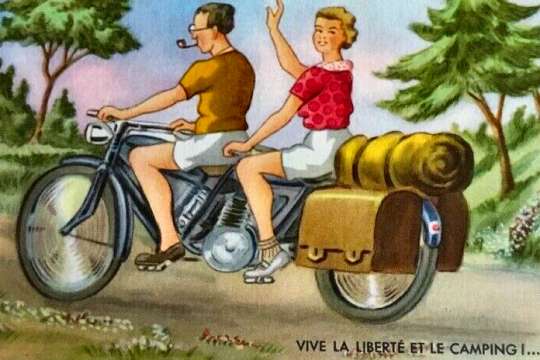
'Long live freedom and camping' recommends this French postcard
Back then, people were traveling more than you might expect and all of Europe was open to them. The postcard was evolving, a boom was being created linked to increased tourism. Sending a postcard of your holiday was becoming something of a required habit.
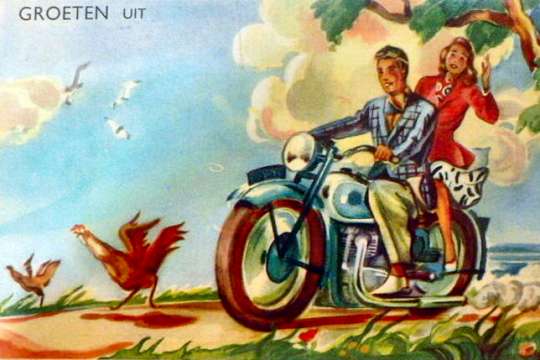
A greetings postcard printed in Holland
French author Georges Duhamel wrote:
The invention of the postcard did more for tourism than that of the railways.
I'm not sure that's true, but the desire to show one's friends just where you'd been and how well travelled you were had something to do with it.
All manner of greetings were sent by postcard, humorous, fantasy-themed, caricature, even politically orientated and of course saucy. The saucier aspects of the more racy cards sometimes got publishers into trouble.
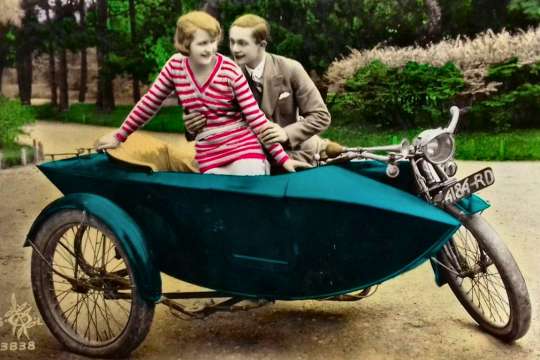
Heliogravure, a faster and less expensive process discovered in 1875 but applied to postcards only after 1918, became widespread from 1923. Printers then used trendy hues: sepia, blue, green or purple.
The First World War gave new impetus to the exchange of postcards as millions of men were stationed far from their families and loved ones.
Despite censorship, this was the only link allowing the soldier to hear from his family and prove that he was still alive.
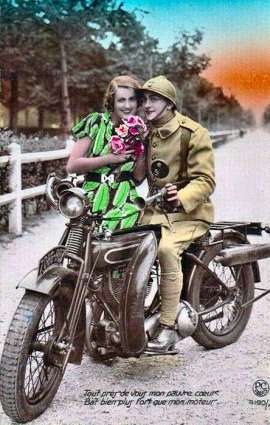
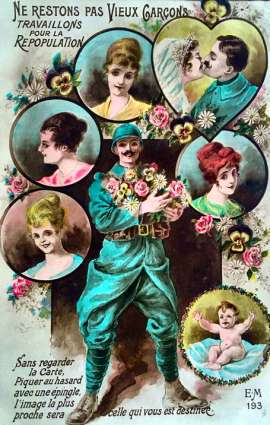
'Let's not stay old bachelors. Let's work for re-population' says the postcard on the right displaying the portraits of potential female conquests.Between 1914 and 1918, 2,000,000 French soldiers died in the fighting (without counting the colonials, the missing and without the figures for the Spanish flu). After the state sent its citizens to war, it now asked them to make love to re-populate the country
The illustrations were often thinly disguised state propaganda, but the correspondence itself was of course the real message.
Cards posted from numerous garrisons and convalescent homes were not subject to the same rigorous censorship as at the front so gave a lot of more detail of daily life and the morale of the troops.
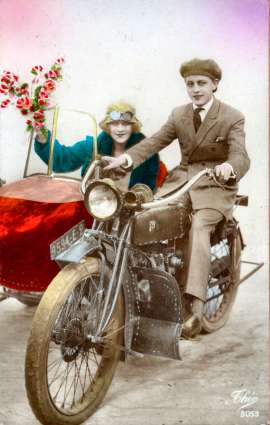
At the time, no publisher knew when the war would end, so we saw an evolution of captions: Campaign of 1914, War of 1914, International War, War of 1914-1915, Great War 1914-1917, Great War 1914-1918.
As if to start afresh after these terrible war years, people seemed to turn away from postcards in the 1920s.
The coming together of families, growing competition from the telephone and telegraph, the use of photography in the press and the development of the automobile, all contributed to making the postcard obsolescent.
The economic crisis of the 1930s and the Second World War only further served to hasten the decline of the postcard throughout Europe.
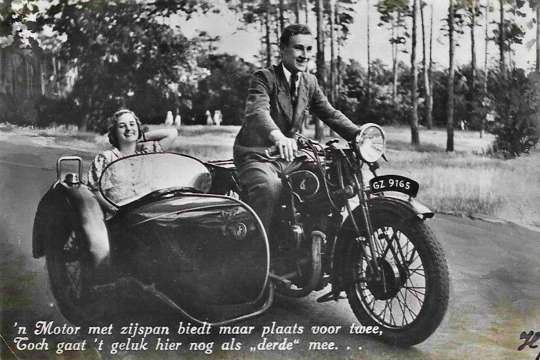
A German postcard testifies to what the motorcycle industry of this country knew how to produce at that time
Neither the use of good quality black and white photography around 1955 and the appearance of colour images during the 1960s succeeded in relaunching the postcard and the postcard today remains a curiosity and somewhat of a rarity.
In the mid - 1970s, old postcards were rediscovered and appreciated because they bear witness to a bygone era.
Old trades, sites, buildings, postcards became popular amongst collectors and those seeking a nostalgic vision of times gone by.
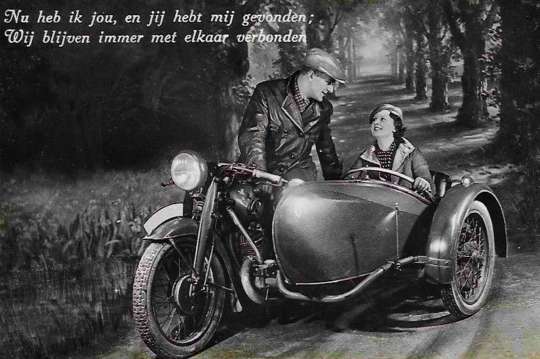
Another postcard from West Germany
Clubs, societies and individuals began to emerge, cataloguing and collecting those untapped postcards of yesteryear that had hither to been sleeping in shoeboxes, in the cellar, the attic or the dark recesses of drawers.
As stocks become scarcer, digital images are now invading our lives. We are, as they say, in the IT age, but are we not perhaps consumed with the era of immediacy?
Telephone, email, social media, websites enable instant communication and are certainly a vital part of modern society, allowing exchanges which are comforting, practical and commercial, but often insignificant, fragmentary and transient.
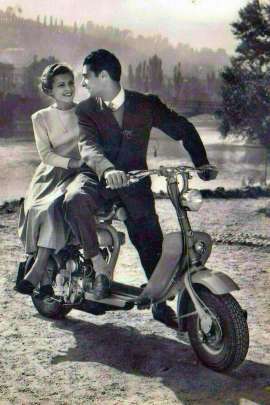
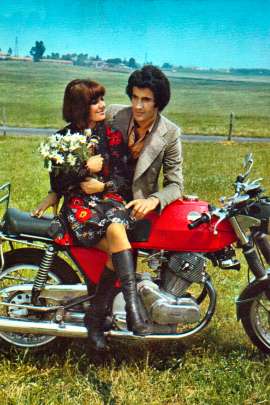
Romeo and Juliet, love is in the air in the Italian countryside
What permanent tactile traces will remain of these in the decades to come? Who knows?
Erased memories, devastating crashes, crippling viruses, incompatible or obsolete systems, all are vagaries of our present IT network and society. Paper and card certainly decay and perish, but the technology of the ether is constantly re-invented, superseding what was thought to be revolutionary at the time and leading to built-in obsolescence and dinosaur-like fragility.
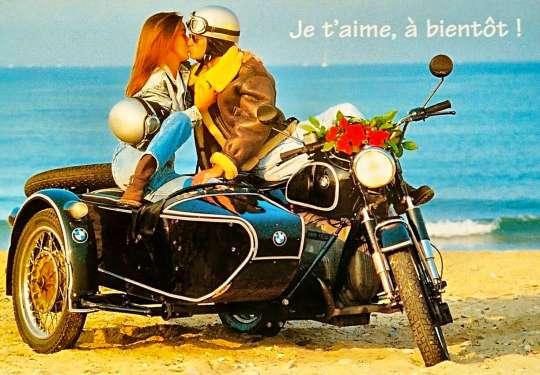
On the occasion of Valentine's Day, we'll end this article with couples and motorcycles and of course a lover's kiss
Perhaps the postcard in all its outdated forms is itself a dinosaur, but at least we can touch it and gaze upon it directly without the aid of any electronic device, and in these difficult times, isn't that what we all want… the direct touch and gaze of another and the tactility that comes with being human?
- Jean-Francois Helias
There is more from Fanfan for this series! A tribute to women on two wheels.
Superbe article! Merci Fanfan pour ce petit coin d'air frais, moins les effluves de nos vieux moteurs de l'époque!
- Fred et Sophie Mabrut
(MC Dragons)
 Superbe article! Merci Fanfan pour ce petit coin d'air frais, moins les effluves de nos vieux moteurs de l'époque!
Superbe article! Merci Fanfan pour ce petit coin d'air frais, moins les effluves de nos vieux moteurs de l'époque!
